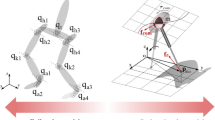Abstract
Although the problem of dynamic locomotion in very rough terrain is critical to the advancement of various areas in robotics and health devices, little progress has been made on generalizing gait behavior with arbitrary paths. Here, we report that perturbation theory, a set of approximation schemes that has roots in celestial mechanics and non-linear dynamical systems, can be adapted to predict the behavior of non closed-form integrable state-space trajectories of a robot’s center of mass, given its arbitrary contact state and center of mass (CoM) geometric path. Given an arbitrary geometric path of the CoM and known step locations, we use perturbation theory to determine phase curves of CoM behavior. We determine step transitions as the points of intersection between adjacent phase curves. To discover intersection points, we fit polynomials to the phase curves of neighboring steps and solve their differential roots. The resulting multi-step phase diagram is the locomotion plan suited to drive the behavior of a robot or device maneuvering in the rough terrain. We provide two main contributions to legged locomotion: (1) predicting CoM state-space behavior for arbitrary paths by means of numerical integration, and (2) finding step transitions by locating common intersection points between neighboring phase curves. Because these points are continuous in phase they correspond to the desired contact switching policy. We validate our results on a human-size avatar navigating in a very rough environment and compare its behavior to a human subject maneuvering through the same terrain.
Access this chapter
Tax calculation will be finalised at checkout
Purchases are for personal use only
Similar content being viewed by others
References
K. Harada, S. Kajita, K. Kaneko, H. Hirukawa, Zmp analysis for arm/leg coordination, in Proceedings of the IEEE/RSJ International Conference on Intelligent Robots and Systems, Las Vegas, USA, October 2003, pp. 75–81
S. Kajita, M. Morisawa, K. Harada, K. Kaneko, F. Kanehiro, K. Fujiwara, H. Hirukawa, Biped walking pattern generator allowing auxiliary zmp control, in Intelligent Robots and Systems, 2006 IEEE/RSJ International Conference on, October 2006, pp. 2993–2999
M. Raibert, Legged Robots that Balance (MIT Press, Cambridge, 1986)
T. Bretl, S. Lall, Testing static equilibrium for legged robots. IEEE Trans. Rob. 24(4), 794–807 (2008)
C. Collette, A. Micaelli, C. Andriot, P. Lemerle, Robust balance optimization control of humanoid robots with multiple non coplanar grasps and frictional contacts, in Proceedings of the IEEE International Conference on Robotics and Automation, Pasadena, USA, May 2008
J. Pratt, R. Tedrake, Velocity-based stability margins for fast bipedal walking, in Fast Motions in Biomechanics and Robotics, ed. by M. Diehl, K. Mombaur, vol. 340, pp. 299–324 (2006)
T. McGeer, Passive dynamic walking. Int. J. Robot. Res. 9(2), 62–68 (1990)
A. Goswami, B. Espiau, A. Kermane, Limit cycles and their stability in a passive bipedal gait, in Proceedings of the IEEE International Conference on Robotics and Automation, April 1996, pp. 246–251
K. Mombaur, H. Bock, J. Schloder, R. Longman, Self-stabilizing somersaults. IEEE Trans. Robot. 21(6), 1148–1157 (2005)
A. Ruina, J. Bertram, M. Srinivasan, A collisional model of the energetic cost of support work qualitatively explains leg sequencing in walking and galloping, pseudo elastic leg behavior in running and the walk-to-run transition. J. Theor. Biol. 237, 170–192 (2005)
T. Takuma, K. Hosoda, Controlling the walking period of a pneumatic muscle walker. Int. J. Robot. Res. 25(9), 861–866 (2006)
E. Westervelt, J. Grizzle, C. Chevallereau, J. Choi, B. Morris, Feebdack Control of Dynamic Bipedal Robot Locomotion (CRC Press, 2007)
B. Stephens, C. Atkeson, Modeling and control of periodic humanoid balance using the linear biped model, in 9th IEEE RAS International Conference on Humanoid Robots, 2009. Humanoids 2009, December 2009, pp. 379–384
J. Rummel, Y. Blum, A. Seyfarth, Robust and efficient walking with spring-like legs. Bioinspir. Biomimet. 5(4), 046004 (2010)
M. Wisse, A. Schwab, R. van der Linde, F. van der Helm, How to keep from falling forward: elementary swing leg action for passive dynamic walkers. IEEE Trans. Robot. 21(3), 393–401 (2005)
K. Byl, R. Tedrake, Metastable walking machines. Int. J. Robot. Res. 28(8), 1040–1064 (2009)
I.R. Manchester, U. Mettin, F. Iida, R. Tedrake, Stable dynamic walking over uneven terrain. Int. J. Robot. Res. 30(3), 265–279 (2011)
M. Spong, J. Holm, D. Lee, Passivity-based control of bipedal locomotion. IEEE Robot. Autom. Mag. 14(2), 30–40 (2007)
M. Zucker, J. Bagnell, C. Atkeson, J. Kuffner, An optimization approach to rough terrain locomotion, in 2010 IEEE International Conference on Robotics and Automation (ICRA), May 2010, pp. 3589–3595
K. Hauser, T. Bretl, K. Harada, J. Latombe, Using motion primitives in probabilistic sample-based planning for humanoid robots, in Workshop on Algorithmic Foundations of Robotic (WAFR), New York, USA, July 2006
K. Bouyarmane, A. Kheddar, Multi-contact stances planning for multiple agents, in Proceedings of the IEEE International Conference on Robotics and Automation, Shanghai, May 2011
L. Sentis, B. Fernandez, Com state space cascading manifolds for planning dynamic locomotion in very rough terrain, in Proceedings of Dynamic Walking 2011, Jena, Germany, July 2011
L. Sentis, J. Park, O. Khatib, Compliant control of multi-contact and center of mass behaviors in humanoid robots. IEEE Trans. Rob. 26(3), 483–501 (2010)
Author information
Authors and Affiliations
Corresponding author
Editor information
Editors and Affiliations
Rights and permissions
Copyright information
© 2017 Springer International Publishing Switzerland
About this chapter
Cite this chapter
Sentis, L., Fernandez, B.R., Slovich, M. (2017). Prediction and Planning Methods of Bipedal Dynamic Locomotion Over Very Rough Terrains. In: Christensen, H., Khatib, O. (eds) Robotics Research . Springer Tracts in Advanced Robotics, vol 100. Springer, Cham. https://doi.org/10.1007/978-3-319-29363-9_34
Download citation
DOI: https://doi.org/10.1007/978-3-319-29363-9_34
Published:
Publisher Name: Springer, Cham
Print ISBN: 978-3-319-29362-2
Online ISBN: 978-3-319-29363-9
eBook Packages: EngineeringEngineering (R0)




